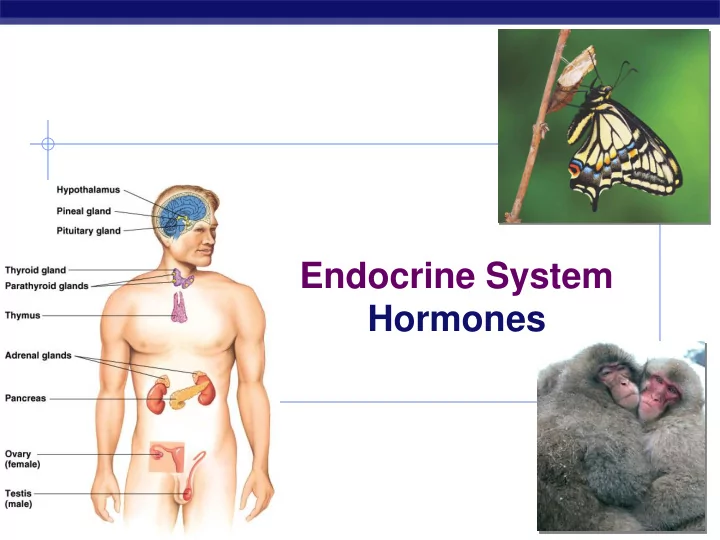

Endocrine System Hormones AP Biology 2007-2008
Regulation Why are hormones needed? chemical messages from one body part to another communication needed to coordinate whole body homeostasis & regulation metabolism growth development maturation reproduction AP Biology growth hormones
Regulation & Communication Animals rely on 2 systems for regulation endocrine system system of ductless glands secrete chemical signals directly into blood chemical travels to target tissue slow, long-lasting response nervous system system of neurons transmits “electrical” signal & release neurotransmitters to target tissue fast, short-lasting response AP Biology
Regulation by chemical messengers Neurotransmitters released by neurons Hormones release by endocrine glands endocrine gland neurotransmitter axon hormone carried by blood receptor proteins receptor proteins AP Biology target cell
Classes of Hormones Protein-based hormones polypeptides small proteins: insulin, ADH insulin glycoproteins large proteins + carbohydrate: FSH, LH amines modified amino acids: epinephrine, melatonin Lipid-based hormones steroids modified cholesterol: sex hormones, aldosterone AP Biology
How do hormones act on target cells Lipid-based hormones hydrophobic & lipid-soluble diffuse across membrane & enter cells bind to receptor proteins in cytoplasm & nucleus bind to DNA as transcription factors Protein-based hormones hydrophilic & not lipid soluble can’t diffuse across membrane receptor proteins in cell membrane trigger signal transduction pathway activate internal cellular response enzyme action, uptake or secretion of molecules… AP Biology
Action of lipid (steroid) hormones steroid hormone target cell blood S S 1 protein S carrier 2 cytoplasm receptor protein 4 transcription factor S 3 DNA 5 mRNA plasma membrane protein nucleus AP Biology ex: growth factors (hair, bone, muscle, gametes)
Action of protein hormones signal-transduction pathway 1 signal protein P plasma membrane hormone activates ion channel or enzyme 2° messenger receptor protein transduction ATP activates 2 enzyme Signal transduction activates cytoplasm pathway enzyme produces an action response 3 AP Biology target cell
Action of epinephrine (adrenalin) epinephrine 1 activates adenylyl cyclase adrenal gland activates G protein cAMP GDP receptor 3 protein 2 ATP activates 4 GTP protein kinase-A activates phosphorylase kinase cytoplasm released activates to blood glycogen phosphorylase 6 glycogen glucose 5 liver cell AP Biology
Maintaining homeostasis hormone 1 lowers gland body condition high specific body condition low raises gland body condition Negative Feedback AP Biology hormone 2 Model
Nervous System Control Feedback Controlling Body Temperature nerve signals hypothalamus sweat dilates surface blood vessels high body temperature (37°C) low hypothalamus constricts surface shiver blood vessels AP Biology nerve signals
Endocrine System Control Feedback Regulation of Blood Sugar insulin beta islet cells body liver stores reduces cells take glycogen appetite pancreas up sugar from blood liver high blood sugar level (90mg/100ml) low liver triggers releases pancreas hunger glucose AP Biology glucagon alpha islet cells liver
Endocrine System Control Feedback Blood Osmolarity osmoreceptors in ADH hypothalamus increased increase water thirst reabsorption pituitary nephron high blood osmolarity JuxtaGlomerular Apparatus nephron low increased nephron adrenal water & salt gland (JGA) reabsorption renin aldosterone angiotensinogen AP Biology angiotensin
COLLECTING INTERSTITIAL Osmoreceptors in FLUID DUCT hypothalamus trigger LUMEN release of ADH. Thirst Hypothalamus COLLECTING DUCT CELL ADH ADH receptor cAMP Drinking reduces blood osmolarity ADH to set point. Second messenger Pituitary signaling molecule Increased gland permeability Storage Distal vesicle tubule Exocytosis Aquaporin water H 2 O channels H 2 O reab- H 2 O STIMULUS: sorption helps Increase in blood prevent further osmolarity osmolarity increase. Collecting duct (b) Homeostasis: Blood osmolarity (300 mOsm/L) (a) AP Biology
Nervous & Endocrine systems linked Hypothalamus = “master nerve control center” nervous system receives information from nerves around body about internal conditions regulates release of hormones from pituitary Pituitary gland = “master gland” endocrine system hypothalamus secretes broad range of hormones regulating other posterior glands pituitary anterior AP Biology
Regulating metabolism Hypothalamus TRH = TSH-releasing hormone Anterior Pituitary TSH = thyroid stimulating hormone Thyroid produces thyroxine hormones metabolism & development bone growth mental development metabolic use of energy blood pressure & heart rate muscle tone digestion tyrosine reproduction + iodine AP Biology thyroxine
Goiter Iodine deficiency causes thyroid to enlarge as it tries to produce thyroxine AP Biology
Endocrine System Control Feedback Regulation of Blood Calcium calcitonin kidney thyroid Ca ++ deposited reabsorption of Ca ++ in bones high blood calcium level (10 mg/100mL) Ca ++ uptake low in intestines activated Vitamin D kidney parathyroid reabsorption bones of Ca ++ release Ca ++ AP Biology parathyroid hormone (PTH)
Feedback Female reproductive cycle egg builds up estrogen matures & uterus lining is released (ovulation) corpus ovary luteum progesterone fertilized egg FSH & LH (zygote) maintains uterus lining pituitary hCG gland yes corpus luteum pregnancy no progesterone GnRH hypothalamus corpus luteum breaks down maintains progesterone drops AP Biology uterus lining menstruation
Recommend
More recommend